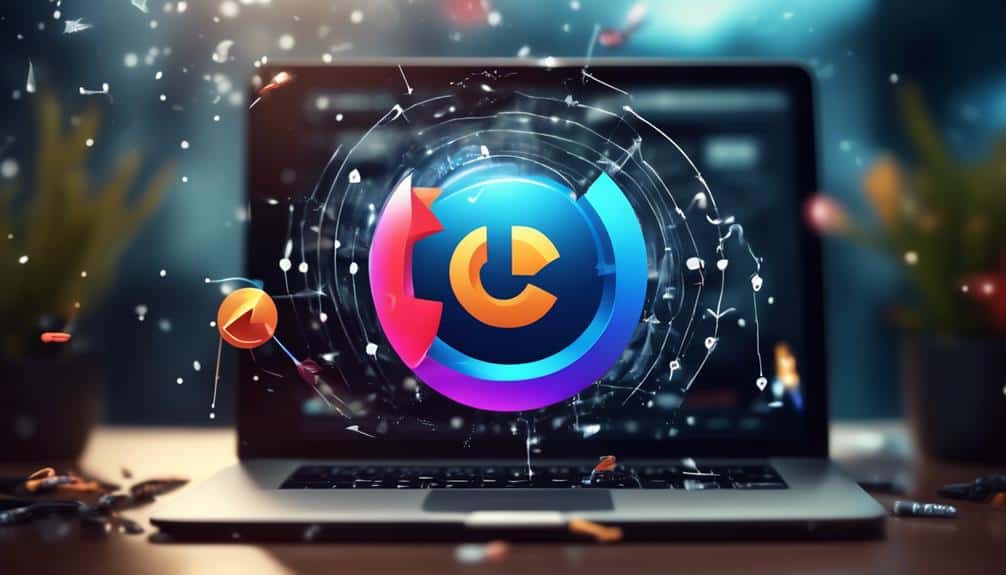Don't Miss: The Ultimate Guide to Caching for Lightning-Fast Websites
Are you tired of waiting for slow-loading websites? Want to enhance the speed and performance of your own website? Look no further than the ultimate guide to caching for lightning-fast websites.
In this comprehensive guide, we will explore why caching is crucial for optimal website performance, delve into the different types of caching and how they work, and provide you with practical tips on implementing browser caching and leveraging content delivery networks (CDNs).
But that's not all – we will also discuss caching for dynamic websites, share best practices for caching optimization, and offer insights on monitoring and troubleshooting caching issues.
Get ready to turbocharge your website's speed and leave your competitors in the dust.
Key Takeaways
- Caching reduces server load and response time, improving website performance.
- Implementing browser caching can significantly decrease page load time for returning visitors.
- Content delivery networks (CDNs) store cached versions of static content globally, reducing access time for users.
- Setting appropriate cache expiration policies strikes a balance between fresh content and avoiding unnecessary requests, leading to significant performance improvements.
Why Caching Is Crucial

Caching is crucial for lightning-fast websites, ensuring optimal performance and an improved user experience. By implementing server-side caching, you can reap a multitude of advantages that have a significant impact on your website's overall performance.
One of the primary advantages of server-side caching is the reduction in server load. When a user requests a page, the server retrieves the required data and stores it in a cache. Subsequent requests for the same page can then be served directly from the cache, eliminating the need for the server to process the request again. This not only reduces the server load but also minimizes the response time, resulting in faster page load times.
Another advantage of caching is improved scalability. With server-side caching, your website can handle a higher volume of traffic without sacrificing performance. By storing frequently accessed data in the cache, you can efficiently serve multiple users simultaneously, ensuring a seamless experience for everyone.
Caching also enhances the user experience by reducing latency. With cached data readily available, pages load faster, leading to a smoother browsing experience. This improved speed and responsiveness not only keeps users engaged but also encourages them to stay longer on your website and explore more.
Understanding Different Types of Caching
Different types of caching play a crucial role in optimizing website performance and improving user experience. By storing frequently accessed data closer to the user, caching reduces the time required to load the requested content, resulting in faster website speeds. It also reduces the load on the server, enabling it to handle more requests simultaneously.
There are different caching strategies that can be implemented to enhance website performance. Understanding these strategies can help you choose the most suitable caching approach for your website. The table below provides a concise overview of different caching strategies and their benefits:
| Cache Strategy | Description | Benefits |
|---|---|---|
| Browser Caching | Caching performed by the user's browser | Decreases page load time for returning visitors |
| CDN Caching | Caching performed by a Content Delivery Network | Reduces server load and improves global website performance |
| Server-Side Caching | Caching performed on the server-side | Enhances website scalability and reduces response time |
| Database Caching | Caching performed on the database level | Improves database query performance |
| Object Caching | Caching of objects or complex data structures | Increases application performance and reduces database load |
Cache expiration refers to the process of determining when cached content should be considered stale and needs to be refreshed. By setting appropriate cache expiration policies, you can strike a balance between serving fresh content and avoiding unnecessary requests to the server. Implementing cache expiration effectively can lead to significant performance improvements and reduced server load.
How to Implement Browser Caching

To implement browser caching, you can configure the caching settings in your web server or utilize caching plugins for popular content management systems. Here's how you can optimize caching performance and enjoy the benefits of browser caching:
- Configure caching settings in your web server:
- Enable caching headers: Set the 'Expires' header to a future date to instruct the browser to cache the resource.
- Set caching rules: Define rules for specific file types or directories to control caching behavior.
- Utilize ETags: Generate a unique identifier for each resource to validate cached versions.
- Utilize caching plugins for popular content management systems (CMS):
- WordPress: Install plugins like W3 Total Cache or WP Super Cache to enable browser caching with a few clicks.
- Drupal: Use modules like Boost or AdvAgg to implement browser caching for your Drupal website.
- Joomla: Install extensions like JotCache or CacheControl to enable caching and improve website performance.
- Consider using a Content Delivery Network (CDN): CDNs store cached versions of your website's static content on servers located worldwide, reducing the distance between your users and the server, resulting in faster load times.
Leveraging Content Delivery Networks (CDNs)
Consider leveraging a Content Delivery Network (CDN) to optimize the performance of your website. CDNs are a network of servers distributed globally that help deliver web content to users more efficiently. By storing copies of your website's static files, such as images, CSS, and JavaScript, in multiple locations, CDNs can reduce the time it takes for users to access your website.
When selecting a CDN for your website, it's important to consider several criteria. First, evaluate the CDN's performance, including factors such as server response time, network latency, and uptime. A reliable CDN with fast servers and a robust infrastructure will ensure a smooth user experience. Additionally, consider the CDN's coverage and the number of edge locations it operates in. The more edge locations a CDN has, the closer the content will be to your users, resulting in faster load times.
To help you make an informed decision, here is a comparison of three popular CDNs:
| CDN | Performance | Coverage |
|---|---|---|
| Cloudflare | Excellent | Global |
| Akamai | Outstanding | Worldwide |
| Fastly | Very Good | Extensive |
Caching for Dynamic Websites

To optimize the performance of dynamic websites, implementing caching mechanisms is crucial. With the right caching strategies and caching plugins, you can dramatically improve the speed and responsiveness of your website.
Here are some key points to consider:
- Client-side Caching: By instructing the user's browser to cache certain static resources, such as CSS and JavaScript files, you can reduce the number of requests made to the server, resulting in faster page loads for returning visitors.
- Server-side Caching: Utilizing server-side caching techniques, such as object caching or page caching, can significantly reduce the processing time needed to generate dynamic content. By storing pre-rendered versions of frequently accessed pages or data, you can deliver content more quickly to your users.
- Database Caching: Caching database queries and query results can greatly improve the performance of database-driven websites. By storing frequently accessed data in memory or using specialized caching systems, you can reduce the load on your database and speed up page rendering.
When it comes to caching for dynamic websites, it's essential to choose the right caching strategies and plugins that align with your specific requirements. Experimenting with different caching techniques and monitoring their impact on your website's performance is key to finding the optimal configuration.
Best Practices for Caching Optimization
Optimize your caching system by implementing these best practices for maximum performance.
Caching strategies play a crucial role in improving website speed and reducing server load. One important aspect of caching optimization is cache expiration. It ensures that outdated content isn't served to users, providing them with the most up-to-date information.
To effectively manage cache expiration, consider using a combination of time-based and action-based strategies. Time-based caching involves setting an expiration time for cached resources, after which they're considered stale and need to be reloaded. This approach ensures that users always receive fresh content, but it may result in increased server load when resources are frequently updated.
Action-based caching, on the other hand, invalidates the cache when specific actions occur, such as content updates or user interactions. This strategy allows for more granular control over cache expiration, reducing unnecessary server requests.
Additionally, consider implementing cache validation mechanisms such as ETags or Last-Modified headers. These techniques allow the server to determine if cached resources have changed since they were last requested, reducing bandwidth usage and improving performance.
Monitoring and Troubleshooting Caching Issues

If you encounter any caching issues, it's important to effectively monitor and troubleshoot them to ensure optimal performance of your website. Here are some tips to help you with monitoring and troubleshooting caching issues:
- Monitor cache performance: Regularly check the performance of your cache to ensure it's working as expected. Use tools like cache hit ratio and cache utilization rate to measure the effectiveness of your cache. Monitoring cache performance will help you identify any potential bottlenecks or issues that may be affecting the performance of your website.
- Check cache invalidation: Cache invalidation is a process of removing old or outdated content from the cache. Make sure that your cache is properly configured to invalidate cached content when it becomes stale or when changes are made to the underlying data. Monitoring cache invalidation will help you ensure that your cache is always serving the most up-to-date content to your users.
- Use logging and analytics: Enable logging and analytics in your caching system to track cache hits, misses, and other relevant metrics. Analyzing these logs will provide valuable insights into the performance of your cache and help you identify any issues or patterns that need attention.
Frequently Asked Questions
How Does Caching Impact Website Performance and Load Times?
Caching impacts website performance and load times by storing data locally, reducing the need for repeated requests. Pro: Faster page loading. Cons: Outdated content. To optimize caching for dynamic content, set appropriate cache-control headers.
Can Caching Be Used for All Types of Websites, Regardless of Their Content or Functionality?
Caching can be used for all types of websites, regardless of content or functionality. It has pros and cons, and optimizing caching for dynamic websites involves techniques like caching database queries and using cache invalidation strategies.
Are There Any Potential Downsides or Risks Associated With Caching?
Potential risks of caching include security vulnerabilities and the possibility of serving outdated content. It's important to regularly review and update your cache to mitigate these drawbacks and ensure optimal performance.
How Often Should Caching Be Refreshed or Updated to Ensure Optimal Performance?
To ensure optimal performance, you should regularly refresh or update your caching. The caching frequency depends on your website's needs and caching strategies. This will help maintain lightning-fast load times for your users.
What Are Some Common Pitfalls or Mistakes to Avoid When Implementing Caching for a Website?
When implementing website caching, be aware of common pitfalls and mistakes. Follow best practices to ensure optimal performance. Avoid issues such as incorrect cache settings, cache validation problems, and not considering dynamic content.
Conclusion
In conclusion, caching is a crucial aspect of website optimization that can significantly improve website speed and performance.
By understanding the different types of caching and implementing browser caching, leveraging CDNs, and following best practices for caching optimization, you can ensure lightning-fast websites.
Monitoring and troubleshooting caching issues will help you maintain an efficient caching system for your dynamic websites.
Implementing these strategies will result in a seamless and efficient user experience.








